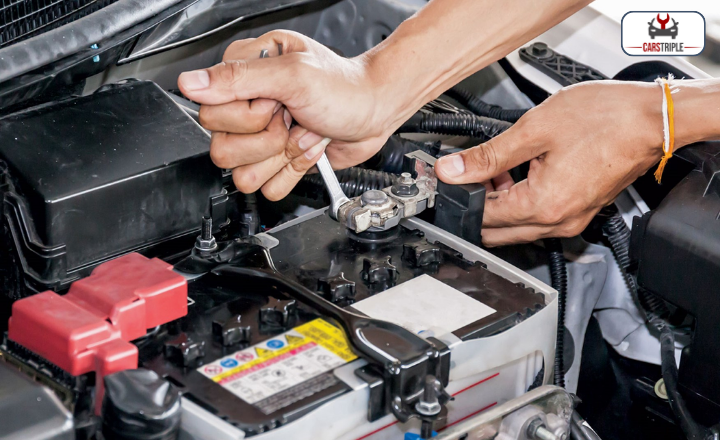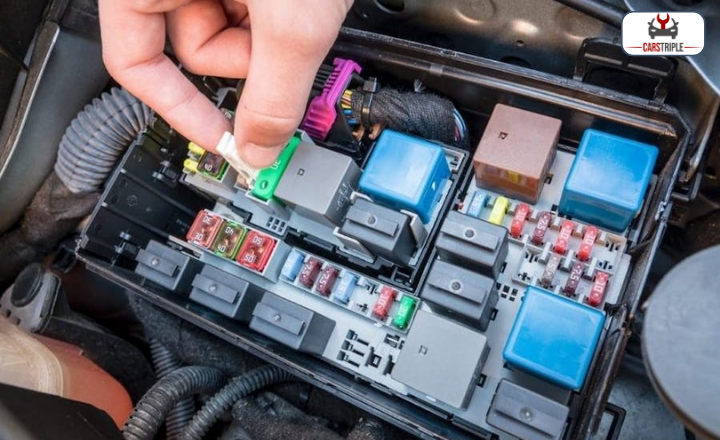Understanding your vehicle’s electrical system can seem enormous, but starting with critical components like the Starter Relay Fuse is an excellent way to unravel its mysteries.
The relay fuse for the starter is essential to your car’s electrical system. It protects the starting mechanism from power surges and short circuits. But if it stops working, your car won’t start. Knowing the signs of a blown starter fuse is like solving a puzzle. Once you figure it out, you can fix the problem and get your car running again. This article will help you understand starter fuses so that you can confidently handle this common issue!
What Does A Starter Relay Do?
The starter relay, also known as the starter solenoid, is an electrical switch that receives a small electric current from the ignition switch when you turn the key. It activates an electromagnet inside the relay, closing a set of internal contacts to send a larger current to the starter motor.
This controlled process is crucial in starting the engine, ensuring the starter motor receives enough power to turn the engine over and start the vehicle. The vehicle would only start with the starter relay due to insufficient power reaching the starter motor.
What Causes The Starter Relay To Become Faulty?
The starter relay can become faulty due to general wear and tear, frequent starts, poor maintenance, or poor-quality relays. Heat, vibration, electrical issues like short circuits or overloads, and corrosion or loose connections can also contribute to its degradation. It’s essential to regularly inspect and maintain the starter relay to prevent potential issues.
How To Test For Starter Relay Issues?
To test for starter relay issues, perform a visual inspection for physical damage, corrosion, or loose connections. Next, use a multimeter to test for electrical continuity by checking the resistance across the coil’s terminals. A high resistance reading could indicate a faulty relay. Lastly, check for voltage at the relay’s power input; if there’s no voltage when the key is turned, the problem may lie elsewhere in the ignition system.
How Do I Know If My Starter Relay Fuse Is Blown?
When your car doesn’t start, the engine doesn’t make any noise, or you hear a clicking sound when you try to turn it on, it might mean the relay fuse for starter has blown. Inspect the fuse for a broken or melted wire inside as a sign of damage.

You can also use a multimeter to check for continuity across the fuse; the fuse is likely blown if there is no continuity. If you suspect a blown relay fuse for starter, it’s best to consult with a professional mechanic for further diagnosis and repair.
What Happens When Relay Fuses for Starter Blows?
If the Relay Fuse for starter blows, it stops the power from reaching the starter motor, which keeps the engine from starting. This will result in the vehicle being unable to start until the blown fuse is replaced. A blown fuse may signify a more significant issue in the electrical system, such as a short circuit or an overloaded component drawing too much current. If a new fuse blows soon after replacement, an underlying issue is likely to be addressed.
Where Is The Relay fuse for starter Located?

The relay fuse for starter is typically located in one of the vehicle’s fuse boxes, with the most common placement being under the hood in the power distribution center. Some vehicles may also have a fuse box inside the cabin. Please consult your owner’s manual or look for a diagram on the fuse box cover to find the exact location of the fuse and its rating.
Signs That Your Starter Relay Is Damaged
Here, we have shortlisted a few signs that the relay fuse for a starter is damaged.
Intermittent Issues Starting Your Vehicle

Intermittent starting issues in a vehicle can often be attributed to a faulty starter relay. When the electrical contacts within the relay become worn or pitted, it can lead to an inconsistent connection, causing the car to start OK one moment and then fail to start the next. This irregularity is a common sign of a faulty starter relay and may require replacement to resolve the issue.
No Sound When Starting the Car
If your car makes no noise when you start, the problem might be a broken starter relay. This means that when you turn the key, you won’t hear anything, which shows that the relay isn’t giving power to the starter motor like it’s supposed to.
Clicking Sound When Turning the Key
The clicking sound when turning the key could indicate a faulty starter relay. This happens when the relay cannot pass enough current to the starter motor, preventing the engine from turning over. In this case, it’s best to have the starter relay checked and replaced by a qualified mechanic, if necessary.
It is worth checking the battery connections and the battery’s condition. Poor connections or a weak battery can also cause a clicking sound when starting the car.
Starter Stays On After Engine Started
When the engine keeps running even after you’ve let go of the key, it could mean that the starter relay is stuck in the on position. This can cause serious problems like damaging the starter motor and the reay and draining your car’s battery.
You’ll need to replace the faulty starter relay to fix this issue. It’s a relatively simple and inexpensive fix that can save you from more costly repairs.
Vehicle Starts Without Key
Your car’s engine starting without the key might mean the relay has a problem. The relay is in charge of sending power to the starter motor, and if it gets stuck, it can make the engine start without the key. This doesn’t happen often, but getting it fixed quickly is crucial to prevent more damage to your car.
How To Fix Or Replace Your Starter Relay
You can fix or replace your starter relay by the following way.
Identify the Faulty Relay
Before replacing a faulty relay in your vehicle, it’s essential to identify which one is causing the issue correctly. To do this, refer to your vehicle’s manual to locate the starter relay in the fuse box. Once you’ve found it, visually inspect the relay for any signs of damage or corrosion, as these are common indicators of a faulty relay.
Disconnect the Battery

Disconnecting the vehicle’s battery before making repairs is a crucial safety step. It helps to avoid accidental electrical shocks and prevents the engine from starting unintentionally, which could be dangerous. Disconnecting the battery reduces the risk of electrical accidents and ensures a safer working environment while repairing your vehicle.
Remove the Faulty Relay
To remove a faulty relay from the fuse box, you first need to locate it. Once you’ve found the relay, you can pull it out quickly. Some relays may be bolted in place and require a socket or wrench for removal. In that case, use the appropriate tool to loosen the bolts and carefully remove the faulty relay.
Install the New Relay
After removing the old relay, installing the new one correctly is essential. First, ensure you have the correct type of relay for your vehicle. Check the owner’s manual or consult a mechanic if you need more clarification. You have the correct relay; firmly plug it into the appropriate socket in the fuse box. Make sure it’s seated properly and securely to ensure it functions correctly.
Reconnect the Battery and Test
Re-reconnecting the battery if you’ve installed the new relay in your vehicle is essential. This will allow the electrical system to power up and allow you to test whether the new relay is working correctly. After reconnecting the battery, try starting the vehicle to see if it kicks into action. If it starts up without any issues, then great job! If the car still doesn’t start, another underlying problem could need attention. In that case, it’s best to seek help from a professional mechanic who can diagnose and fix any additional issues.
How Long Does A Starter Relay Typically Last?
The typical lifespan of a starter relay is designed to last as long as the vehicle itself, but several factors can affect its longevity. Under normal conditions, a starter relay can last around 80,000 to 100,000 miles, but this can vary based on usage and maintenance. Factors such as frequent starts, poor maintenance, and low-quality parts can shorten the lifespan of the relay.
Can I Drive With A Faulty Starter Relay?
No, it’s not safe to drive with a faulty starter relay. A faulty starter relay can cause your vehicle trouble starting or even fail to start altogether. This could lead to unexpected power loss while driving, which you do not want to risk. If you think your starter relay is faulty, it’s best to get it replaced as soon as possible to avoid any potential safety hazards on the road.
Is Replacing A Starter Relay Expensive?
Replacing a starter relay is generally not expensive. The part usually costs around $20 to $50, but the labor costs can vary based on where you are and your vehicle type. In some cases, you can replace the starter relay yourself if you’re comfortable with essential car maintenance, which can save on labor costs.
Can A Starter Relay Affect The Battery?

Yes, a faulty starter relay can affect the battery in your car. If the relay gets stuck in the on position, it can make the starter motor run continuously, draining the battery quickly. Also, if the relay isn’t making good contact, it can cause the starter motor to draw more power than usual, leading to a drained battery.
Can A Starter Relay Cause A Car To Stall?
A faulty starter relay can indeed cause a car to stall. If the starter relay gets stuck in the on position, it can draw much power from the battery while the vehicle runs. This can lead to decreased power for other vehicle functions, potentially causing the car to stall.
Can A Bad Starter Relay Drain My Battery?
A lousy starter relay can drain your battery. When the relay gets stuck in the on position, it keeps sending power to the starter motor even when the engine is not running. This continuous operation of the starter motor can draw significant power from the battery, leading to a drained battery over time.
Can You Bypass A Starter Relay?
Bypassing a starter relay is not a good idea. The starter relay is there to handle the high current needed by the starter motor, and skipping it could cause damage to other components in your car. It’s designed to keep everything running smoothly and safely, so messing with it could lead to electrical problems or even fires.
Can A Starter Relay Fuse Be Repaired?
Relay fuses for starter are typically not designed to be repaired and should be replaced if blown. Trying to fix a blown fuse can be risky and may lead to additional harm to your vehicle’s electrical system. It’s best to replace the blown relay fuse for starter with a new one, following the manufacturer’s guidelines for the correct replacement part.
How Often Should I Replace My Starter Relay Fuse?
The relay fuse for starter should last the entire lifespan of your vehicle without needing replacement. It’s designed to handle the expected electrical load to start the engine. However, if you find yourself replacing the fuse frequently, it could indicate a problem with your vehicle’s electrical system.
Can A Bad Starter Relay Cause A Check Engine Light?
A lousy starter relay can indirectly cause the check engine light to come on. If the starter relay breaks, it can stop the car from starting and make the check engine light come on. The check engine light tells you if there’s a problem with your vehicle, so it’s best to get it checked by a professional.
Conclusion
Recognizing the symptoms of a blown starter relay fuse is crucial in maintaining the functionality of your vehicle. You can quickly identify if the starter fuse is at fault by paying attention to signs such as a non-responsive starter, dimming dashboard lights, or a clicking sound when turning the key. Testing the fuse with a multimeter and replacing it if necessary is a straightforward process that can save you time and money in the long run. Learning how to test and fix a blown starter fuse will help keep your vehicle running smoothly and prevent potential breakdowns. So, next time you encounter these symptoms, don’t hesitate to take action and ensure your car’s electrical system is in top condition.
FAQ’s
What should I do if replacing the fuse doesn’t solve the problem?
If replacing the fuse doesn’t fix the issue, an underlying electrical problem may require professional diagnosis and repair.
Can I prevent my relay fuse for starter from blowing again?
Regularly inspecting your car’s electrical system and addressing any underlying issues can help prevent future blown fuses.

